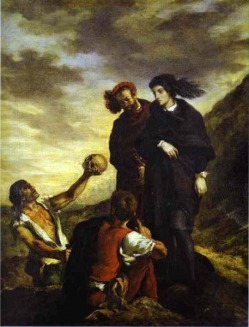This project is dedicated to the legacy of William Shakespeare, the most versatile mind the world has ever produced, and to those people who want to take the time and the effort to meaningfully read his greatest work, Hamlet.
Although I left the classroom in June of 2006 after a teaching career of 30 years, this project has its genesis in something I suspect many retired teachers experience: a recurring dream, more like a nightmare, in which I have only two or three weeks left in the semester, and I still haven’t taught the Shakepearean component, usually either Hamlet or Macbeth. In the dream, as in real life, I tell my students that I left it to the end because otherwise I would have spent far too long on it throughout the semester. The problems I confront in the nightmare are: a) three weeks are not nearly enough time to do justice to Hamlet, and b) I can’t seem to find a sufficient number of copies of the play to meet my students’ needs.
Until recently, I viewed this recurring nocturnal experience as simply a form of anxiety dream, its particulars no doubt attributable to the crucible of the classroom that was my life for so long. Then another interpretation occurred to me. Perhaps the dream is an indication of unfinished business, the suggestion that “some work of noble note” might yet be accomplished. So here’s my plan: to set down in as much detail as is practical what I know about Hamlet, informed by my experiences both as a teacher and a student of Shakespeare, as well as my experience simply as a human being, the latter especially important since the Bard speaks to all of us, as long as we are willing to listen and learn from him. The one area in which I have deliberately curbed my analysis is the language of the play, which might seem an odd choice given the Bard’s mastery of style. I made this decision for two reasons: a good text with well-developed side notes will be of tremendous help in decoding the figurative language of the play, plus the sophistication of the play’s language is such that I would have had to comment on most lines, which would have resulted in a commentary of interminable length. Rest assured, however, that when there is special language significance, I do address it.
While I conceive of this project as being potentially useful to teachers of the play, especially those early in their careers who perhaps lack confidence in tackling what many consider to be Shakespeare’s most complex work, it is not intended as a manual on how to teach the play. That I leave to the increasingly imaginative and energetic ranks of new instructors. It is, however, based on two components that I think are essential in any teaching situation: a deep knowledge and understanding of the material, and informed choices as to what to emphasize in one’s teaching. Just as in my dream, in the classroom there is never enough time to do complete justice to a great piece of literature, so one has to compromise and make the best choices possible. Those choices, of course, will very much depend upon one’s knowledge of the work, coupled with professional judgment and instincts. Therefore, while this work will render as complete an analysis and commentary that I am capable of, I do expect that teachers will make their own choices as to what to emphasize. Additionally, teachers will find this commentary easily adaptable for students who may be away due to protracted illnesses, family vacations, etc., thereby making easier the often time-consuming task of preparing work for them.
But my other intended audience is anyone who wants to read the play and engage with the issues, themes, language and characters that Shakespeare so wonderfully develops. Not all of us may have had the benefit of a good English education, but I am convinced that anyone with a keen interest in the human condition who wants to know and understand some of the Bard’s insights will benefit from this project, using it, hopefully, as a kind of guide while reading the play. Speaking of which …. There really is no substitute for a close and careful reading of the play. My suggestion is that you read a scene slowly, making full use of the sidenotes or endnotes, and then read it a second time, supplemented by my commentary.
My intention here is not to produce another version of Cliff or Coles Notes, with its typical breakdown into plot, character, themes, imagery, etc. Yes, I will deal with each of those, and more, but the bulk of the commentary will be done within the play’s specific context, which is pretty much as it would unfold in a classroom with some dynamic discussion going on. There will, of course, be additional notes at the end of scenes and acts, either to reinforce points made within the commentary, or to provide a broader view of issues that have arisen throughout the act.
Just one final note before I embark on what I anticipate will be a long journey: I make no claim to any special insights or degree of scholarship in what I am offering here. What I learned over the years in teaching Hamlet came from extensive reading, extensive reflection, and the dynamic exchange of ideas with my students. When the latter were fully engaged, the play was both a joy to teach and a learning opportunity for me, as they often made observations that hadn’t even occurred to me. So my gratitude rests with those students, the myriad scholars and critics of the play, and to Shakespeare himself who, in Hamlet, created the most fully-realized human being that I have ever encountered in literature.
Lorne Warwick

